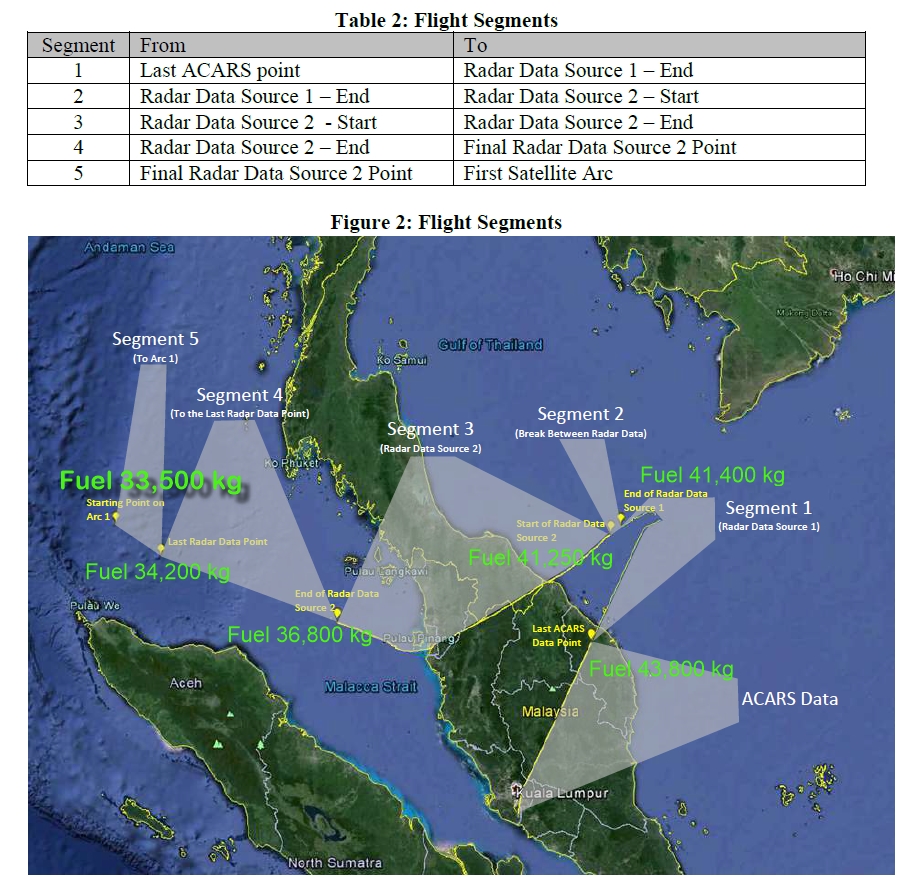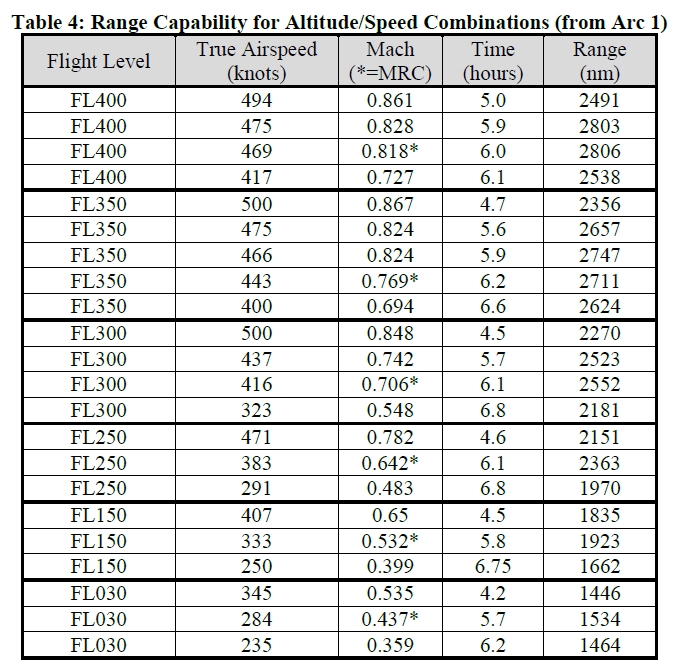Endurance in aviation terms, is the time an aircraft can remain in the air given the amount of fuel carried when airborne. In the case of MH370, it became airborne from Kuala Lumpur International Airport (WMKK) at 16:42 UTC carrying 49,200 kg of fuel, and is widely thought to have crashed around 00:19 UTC. This gave MH370 an endurance of around 7 hours and 35 minutes*1, with an average fuel flow of 6,500 kg/hr.
1. Aim
The aim of this article is to investigate whether, hypothetically, MH370 (9M-MRO) with 49,200 kg of fuel onboard could fly beyond 00:19 UTC. Or to put it in another way, could the fuel MH370 had on departure last longer than 7 hours and 35 minutes?
This question can be best answered by referring to the document ‘Boeing Performance Analysis- Malaysian Airlines 777 9M-MRO 08 March 2014’, which is included in Safety Investigation Report, 2018 as appendix 1.6E.
2. Segment 1 to 5
In determining how far and how long MH370 could have theoretically flown, Boeing divided the flight in to 6 segments. Segments 1 to 5 are shown below, with my annotations in green for the estimated fuel remaining at the end of each segment. The fuel at the end of segment 5, which corresponds with the first Inmarsat ping, Arc 1, was 33,500 kg and is used as the starting point for determining MH370's endurance and range for the remainder of the flight.

An estimate of the average fuel flow during the cruise phase of flight can be determined from the 17:07 ACARS position report, which corresponds with the start of segment 1. This showed MH370 had 43,800 kg at a cruising altitude of 35,000 ft. Between the start of segment 1 to the end of segment 5, MH370 han an estimated fuel burn of 10,300 kg over a time interval of 1 hour and 21 minutes, giving an average cruise fuel flow of 7,600 kg/hr.
3. The Final Segment
The final segment of the flight began at Arc 1 with 33,500 kg of fuel and ended when the aircraft exhausted all of this fuel. As the altitude and airspeed for this final segment were unknown, Boeing calculated a range of speeds between the minimum possible cruise speed to the maximum operating speed for 6 different flight levels, ranging from FL400 (40,000 ft) to FL030 (3000 ft). This is tabulated below in Table 4 showing the Range Capability for various altitude and airspeed combinations from Arc 1, to the end point at fuel exhaustion.
Of interest is the 'Time' column, as this indicates how long MH370 could have remained flying from 18:28 UTC until it ran out of fuel. The reason why there are a number of different possible end points is because an aircraft's fuel burn is affected by its cruising altitude*3 and engine thrust settings*4 amongst other factors.

There is very good evidence to suggest that MH370 crashed very near to Arc 7. Since Arc 7 occurred at 00:19 UTC, which is 6 hours and 9 minutes after the Arc 1 time of 18:28 UTC, then the rows which includes ‘Time’ equalling as close to 6.1 to 6.2 hours are good candidates for where the end point for MH370 is.
Furthermore, any ‘Time’ value greater than 6.2 hours suggests that MH370 could have flown beyond 00:19 UTC with the fuel it had onboard on departure from Kuala Lumpur.
The highest value for ‘Time’ in table 4 above is 6.8 hours which corresponds to 6 hours and 48 minutes, giving an end of flight time of 01:16 UTC. This can occur when cruising at FL300 and FL250 with engine thrust settings giving true airspeeds of 323 knots and 291 knots (nautical miles per hour).
So, the answer to the aim of this article of whether MH370 had the fuel to fly beyond 00:19 UTC, is YES.
4. Why MH370 Has Not Been Found
Despite the calculations that Boeing have made, as well as other supporting scientific and mathematical analysis by other experts, two extensive searches for MH370 near Arc 7 have failed to find the aircraft. The reason for this may be attributed to not having enough information about MH370's actual flight characteristics beyond the last ACARS position report at 17:07 UTC. As a result, assumptions had to be made for the aircraft's flight to fuel exhaustion, such as the aircraft's cruising altitude, airspeeds and engine thrust settings, automatic pilot mode and even whether the flight was flown entirely on automatic pilot engaged or with it off.
If any of these assumptions were wrong, then there is a greater chance that the aircraft did not end up where the mathematics suggest it would. To quote Dr. Neil Gordon from the Defense Science and Technology Group, Australia, who's group was tasked with narrowing down the search area for MH370 through analyzing the satellite communications data, "The sort of difficulty we always come up with is, at the end of the day it’s a probability distribution, it’s not an analytic solution with a guarantee. It’s a distribution that represents the prioritized belief as to where you think it is relative to other places." *5
The assumptions that were made in coming up with the Arc 7 search area is a whole topic in itself and will be discussed in a separate forthcoming article.
Footnotes:
*1. Reserve fuel is not included in this calculation.
*2. For an explanation of the Inmarsat ping arcs, refer here.
*3. Generally, the higher altitude, the less the fuel burn.
*4. Generally, the higher the thrust, the faster the speed, and the higher the fuel burn.
*5 Source from Jeff Wise's exclusive interview with Dr. Neil Gordon from the DSTG.